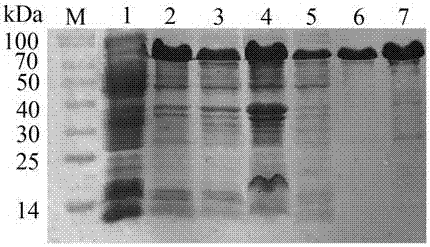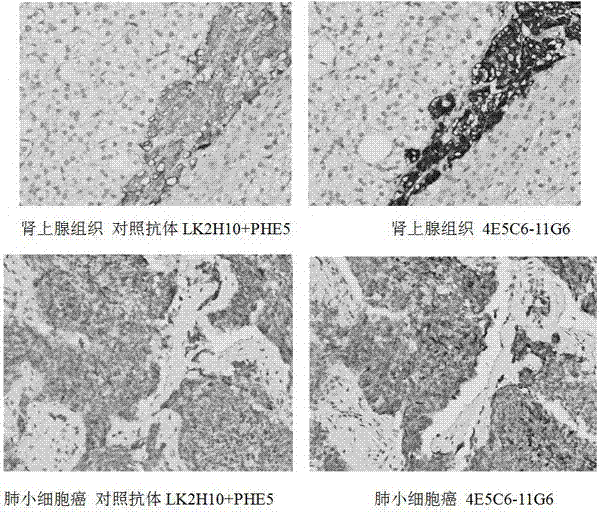Hybridoma cell line for secreting monoclonal antibody against chromogranin A and application of hybridoma cell line
A hybridoma cell line, monoclonal antibody technology, applied in the direction of anti-receptor/cell surface antigen/cell surface determinant immunoglobulin, anti-animal/human immunoglobulin, analytical materials, etc., can solve the problem of anti-CgA antibody Apply for patents and other issues to achieve the effects of high specificity and sensitivity, good positioning, and improved accuracy
- Summary
- Abstract
- Description
- Claims
- Application Information
AI Technical Summary
Problems solved by technology
Method used
Image
Examples
Embodiment 1
[0035] Example 1 Preparation of recombinant CgA protein fragments
[0036] 1. Gene optimization and synthesis
[0037] According to the protein sequence with the accession number P10645 in the Uniprot database, CgA selects the protein fragment from the 19th to the 457th amino acid, and directly optimizes it into a gene fragment suitable for expression in Escherichia coli BL21 (DE3). In the process of PCR, the 5' and 3' ends of the gene were respectively added EcoR I and HindⅢ Restriction site. The PCR products were separated by agarose gel electrophoresis and recovered, and the recovered fusion protein gene and the plasmid vector pET-28a used for expression were analyzed respectively. EcoR I and Hind Digested with enzyme III, recovered by electrophoresis again, and ligated with T4 DNA ligase. The ligation product was transformed into Escherichia coli competent cell BL21(DE3), and the clones on the plate were picked and inoculated, and the bacteria liquid PCR was ident...
Embodiment 2
[0040] Example 2 Establishment of hybridoma cell lines
[0041] 1. Immunity
[0042] Mix the fusion protein purified in Example 1 and rapid adjuvant (Beijing Boaolong Company) according to the instructions, and immunize 4-6 week-old female BALB / c mice (purchased from Shanghai Wu’s Experimental Animal Center). Calf intramuscular injection, the dose is 50 µg / head. On the 21st day, one shot of booster immunization was given in the same way. On the 35th day, indirect ELISA (wavelength 450 nm) was used to detect the polyantibody titer of the anti-immunogen in the mouse serum, and the mouse with the highest titer was immunized by intraperitoneal injection, and the antigen was mixed with normal saline, and the dose was 50 μg / mouse .
[0043] 2. Cell Fusion
[0044] Aseptically prepare the immune-qualified mouse splenocyte suspension, mix it with mouse myeloma cell SP2 / 0 (Shanghai Cell Bank, Chinese Academy of Sciences) at a volume ratio of 5:1, and centrifuge at 1500 rpm for 5 mi...
Embodiment 3
[0047] Example 3 Preparation of monoclonal antibody by ascites induction method
[0048] 1. Ascites preparation
[0049] Cells in the logarithmic growth phase were washed with serum-free medium and suspended, counting 5×10 5 , 1ml. The suspended cells were injected intraperitoneally into mice previously sensitized with paraffin oil. Ascites collection was started 7 days later. The removed ascites was centrifuged at 4°C at 4000 rpm for 10 min. Carefully suck out the ascites in the middle and collect in a centrifuge tube, and store at 4°C or -20°C.
[0050] 2. Purification of monoclonal antibodies
[0051] Antibodies were purified from ascites by ProteinG (Nanjing GenScript) affinity chromatography according to the instructions. The purity was identified by SDS-PAGE gel, and the concentration was determined by BCA method. Purified antibodies were stored at -20°C.
PUM
| Property | Measurement | Unit |
|---|---|---|
| Melting point | aaaaa | aaaaa |
Abstract
Description
Claims
Application Information
 Login to View More
Login to View More - R&D
- Intellectual Property
- Life Sciences
- Materials
- Tech Scout
- Unparalleled Data Quality
- Higher Quality Content
- 60% Fewer Hallucinations
Browse by: Latest US Patents, China's latest patents, Technical Efficacy Thesaurus, Application Domain, Technology Topic, Popular Technical Reports.
© 2025 PatSnap. All rights reserved.Legal|Privacy policy|Modern Slavery Act Transparency Statement|Sitemap|About US| Contact US: help@patsnap.com



